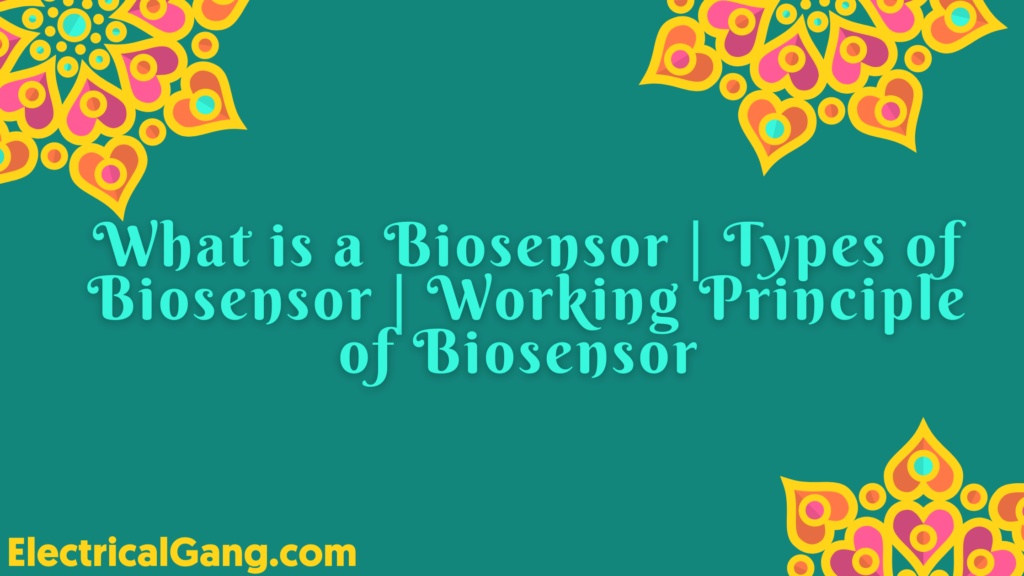
The first biosensor was invented by the American biochemist “L. L. Clark” in 1950. This biosensor is used to gauge oxygen in the blood. The sensor electrode used in this sensor is named the Clark electrode or oxygen electrode. A gel containing the enzyme glucose oxidase is then applied to the oxygen electrode to calculate blood sugar. The corresponding enzyme urea was used with an electrode. Which was invented specifically for NH4 ++ ions to calculate urea in body fluids such as urine and blood.
There are three generations of biosensors available in the market. In the first type of biosensor, the reaction of the product is transmitted to the sensor and causes an electrical reaction. The second type of biosensor involves special mediators between the sensor and the response to get a better response.
In the third type of biosensor, the response itself causes the reaction. It does not include any kind of mediation. In today’s article, we will see what is a biosensor, how many types of biosensors are there, what are the applications of a biosensor, etc. We will see information in today’s article.
Suggested Read: What is an Electrical Transducer? | Types of Electrical Transducer
What is a Biosensor?
The biosensor can define as an analytical device. This includes a combination of biological detectors such as sensor systems and transducers. When we compare it with any diagnostic device currently present. These sensors are then advanced in the state of selection as well as in the state of sensitivity.
The main application of this biosensor involves the investigation of environmental pollution control in the agricultural sector as well as in the food industry. The main features of a biosensor are stability, cost, fertility, and sensitivity.
The short form of the biological sensor is known as a biosensor. These sensors probably contain enzymes as biological elements. If not nucleic acid then antibody. The bio-element communicates by being tested by the analyzer and the biological response can be converted into an electrical signal using a transducer.
Biosensors are classified into different types depending on the application. Such as resonant mirrors, chemical canaries, immune, optrodes, bio-computers, glucometers & biochips.
Main Components of a Biosensor:
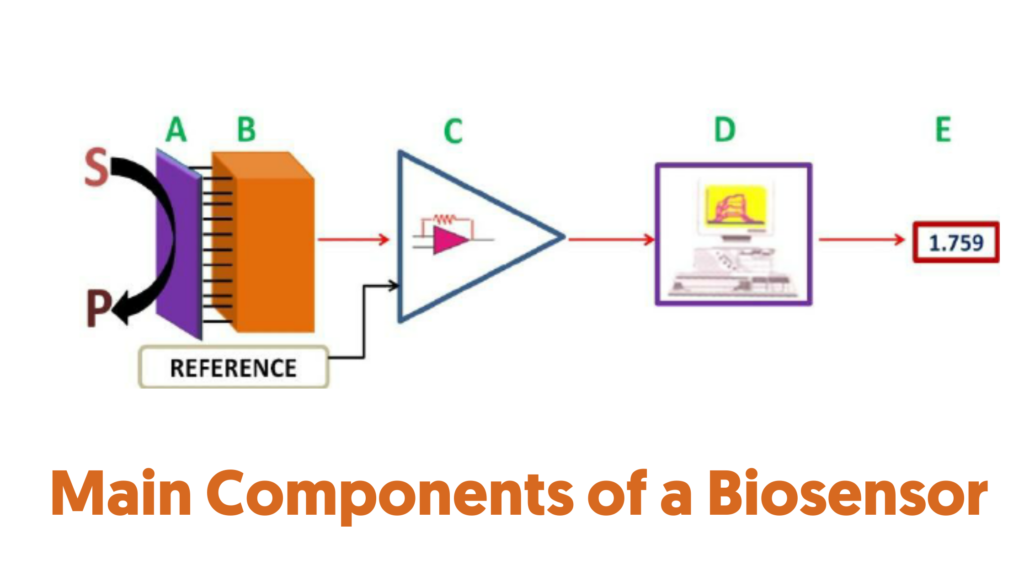
Image Source: www.researchgate.net
The block diagram of the Biosensor is as follows which consists of three main segments. One is the sensor, the other is the transducer and the third is the relative electron. The first segment has sensors that respond to biological parts. The second segment is the detector part which changes the signal of the result from the contact of the analyst. And display the result correctly. The last part has an amplifier known as a signal conditioning circuit, a display unit as well a processor.
Working Principle of Biosensor:
The enzyme or preferably biological material is usually inactivated by some specific method. Inert biological material is in close contact with the transducer. The analyzer combines with the biological substance to shape the clear analyzer. Which in turn gives an electronic response that can be calculated.
In some instances, the analyzer is converted into a device that can be connected to the discharge of gas, heat electron ions, or hydrogen ions. In this, the transducer can convert the device connected to it into an electrical signal. Which can be changed and calculated.
Working of Biosensors:
The electrical signal from the transducer is often low and overlays on a very high baseline. Usually, the signal processing position involves cutting the baseline signal. Which any biocatalyst obtains from the respective transducer without cover.
The relatively slow character of the biosensor response significantly alleviates the issue of electrical noise filtration. The direct output in this phase will be the analog signal. However, it has changed to digital form and is accepted in the microprocessor phase where information progresses, influences select units, and outputs to the datastore.
Suggested Read: Optical Sensor Basics | Types of Optical Sensor | Applications of Optical Sensors
Types of Biosensors:
Depending on the sensor device and biological material it can be classified into different types which are as follows:
| Sr. No. | Types of Biosensors |
| #1. | Electrochemical Biosensor |
| #2. | Physical Biosensor |
| #3. | Piezoelectric Biosensors |
| #4. | Thermometric Biosensor |
| #5. | Optical Biosensor |
| #6. | Wearable Biosensors |
| #7. | Enzyme Biosensor |
| #8. | DNA Biosensor |
| #9. | Immunosensors |
| #10. | Magnetic Biosensors |
| #11. | Resonant Biosensors |
| #12. | Thermal Detection Biosensor |
#1. Electrochemical Biosensor:
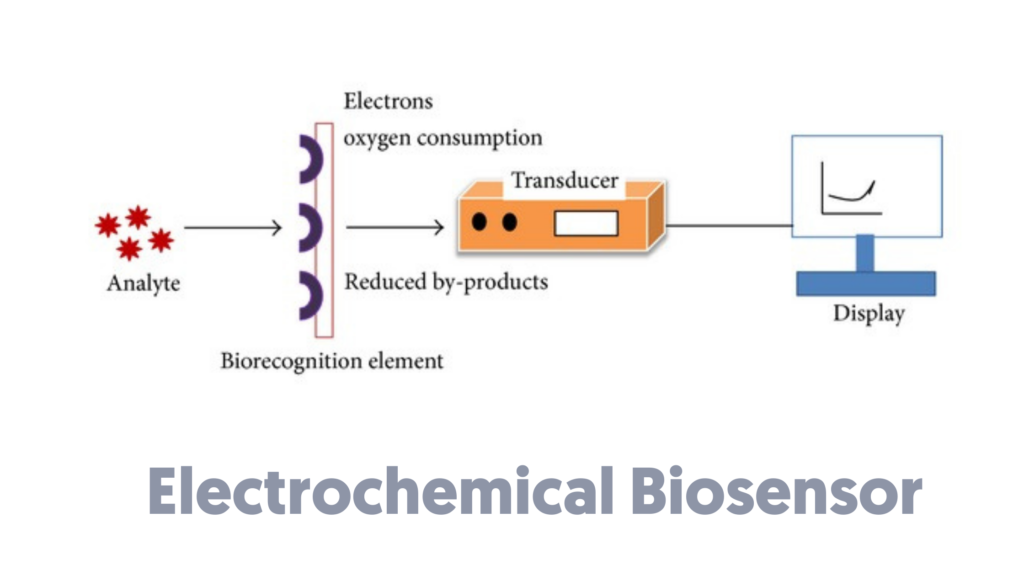
Image Source: www.researchgate.net
This biosensor depends on the response of the enzymatic catalysis. Which consumes electrons. This type of enzyme is named Redox Enzymes. The substrate of this biosensor usually consists of three electrodes as counter, reference, and working type.
The object analyzer is engaged in the response to the surface of the active electrode. This reaction can also transfer electrons to the dual-layer potential. The current can be calculated on a set potential.
These biosensors are classified into four types. These are as follows:
- Amperometric Biosensors.
- Potentiometric Biosensors.
- Impedimetric Biosensors.
- Voltammetric Biosensors.
#1.1. Amperometric Biosensors:
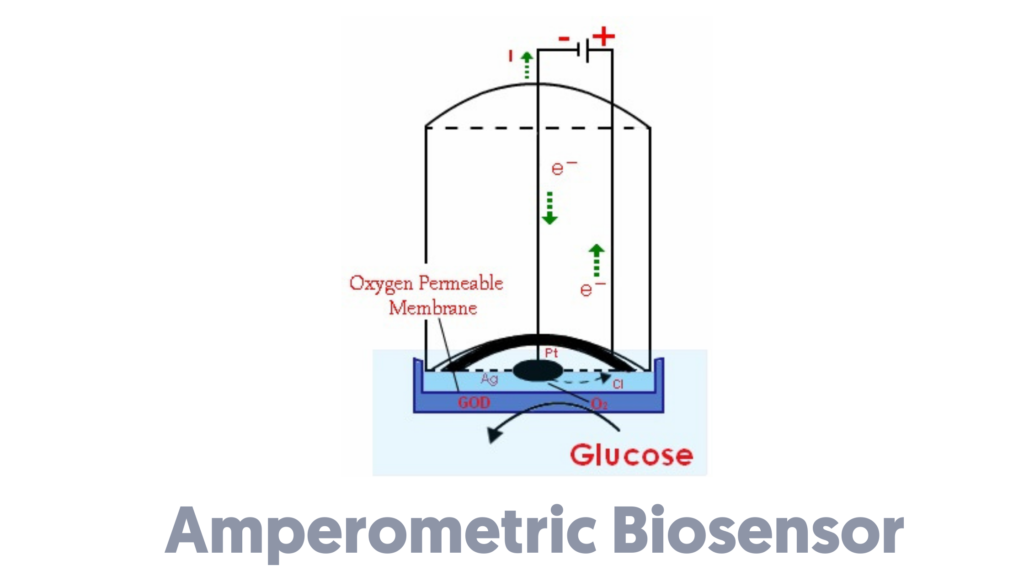
This type of biosensor is a self-contained device that provides accurate quantitative analytical information based on the amount of current coming from the oxidation. In general, the reaction time, powerful range, and sensitivity in these biosensors are comparable to potentiometric biosensors.
Irregular use of a simple Amperometric Biosensor involves the “Clark Oxygen” electrode. The law of this biosensor is based on the amount of current flowing between the counter electrode and the working. Which is stimulated by the redox response on the operational re-electrode.
#1.2. Potentiometric Biosensor:
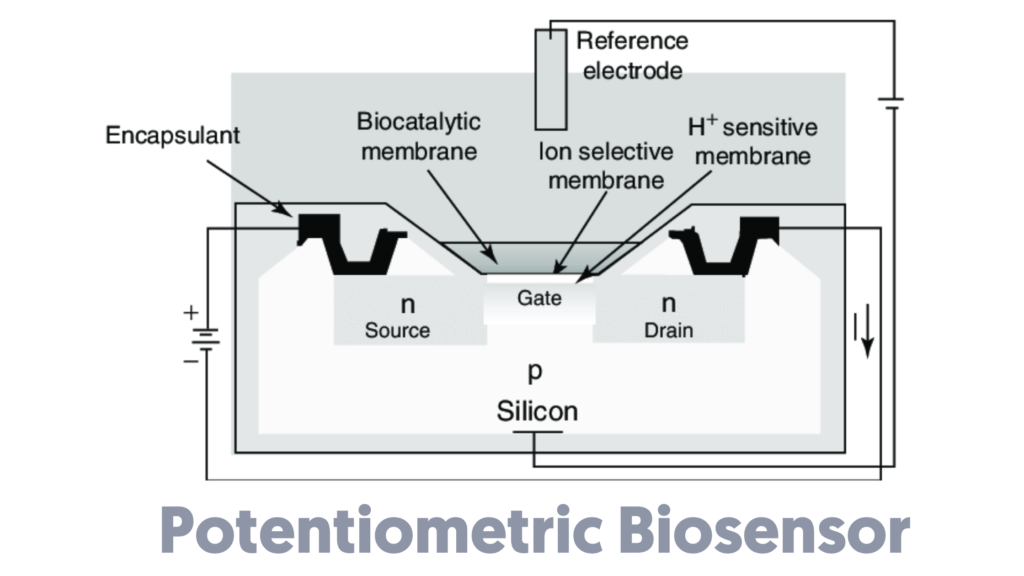
Image Source: www.researchgate.net
This type of biosensor provides a logarithmic answer through a series of high-energy series. This is accomplished by monitoring the production of electrode prototypes frequently cast on synthetic substrates in biosensors, covered with performing polymers with some enzymes.
This involves two electrodes. Which is very responsive and strong. They recognize analysts at a stage before they can be achieved by HPLC, LC / MS, and without the preparation of a specific model.
Each type of biosensor usually produces at least one sample. As the biological finder is very selective for the troubled analyst. The signal will be generated by the driven coating of the polymer due to the changes taking place in the outer part of the biosensor due to physical and electrochemical changes.
This change can be attributed to the ionic force hydration, pH, and redox response, the latter being labeled as an enzyme, the latter moving over the substrate. The gate terminal has been replaced by an antibody or enzyme in FET. This may also receive very little attention from various analysts as the required analyzer towards the gate terminal changes the source flow in the drain.
The main types of potentiometric biosensors are based on the ISE or ion-selective electrodes membrane, Electrophysized polymers by chemical means such as ISFET (ion-selective field-effect transistors), solid-state devices, metal oxides otherwise electroporated polymers.
#1.3. Impedimetric Biosensors:
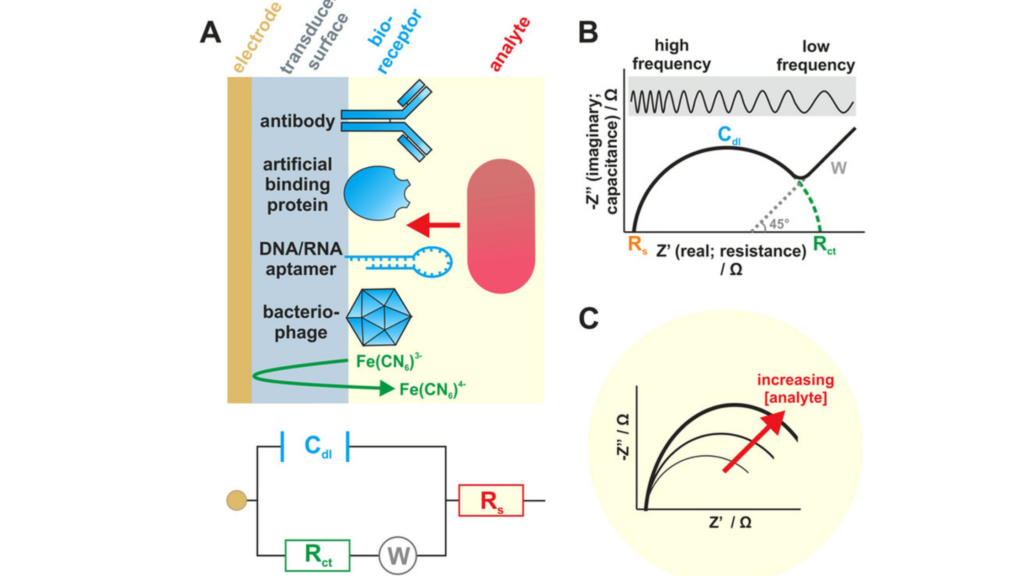
Image Source: www.researchgate.net
EIS is an influential indicator for a wide range of physical and chemical properties. A growing trend toward the expansion of impedimetric biosensors is currently being observed. Impedimetric techniques have been used to isolate the detection of biosensors as well as to investigate the catalytic responses of enzymes lectins, nucleic acids, receptors, whole cells, and antibodies.
#1.4. Voltammetric Biosensors:
This communication is the basis of a new volumetric biosensor for taking acrylamide into consideration. This biosensor was made from a carbon glue electrode customized with hemoglobin, consisting of four prostatic groups of ham (Fe). This type of electrode shows a reversible oxidation or reduction process of Hb (Fe).
#2. Physical Biosensor:
Physical biosensors are one of the most basic and widely used sensors in classification. The main idea behind this classification is also by observing the human brain. The normal working mechanism behind hearing, sight, and tactile intelligence is to respond to external physical stimuli, hence any device that responds to the physical property of the medium is called a physical biosensor.
Physical biosensors are classified into two types as follows:
- Piezoelectric Biosensors.
- Thermometric Biosensor.
#2.1. Piezoelectric Biosensors:

Image Source: www.sciencedirect.com
This sensor is a collection of analytical devices that work on the working principle of “Affinity Interaction Recording”. A piezoelectric platform is a sensor element that works on the law of oscillation. Which is converted due to a storage jump on the surface of the piezoelectric crystal.
In this analysis, antigens or antibodies, molecularly stamped polymers, and biosensors with inherited information have their modified surfaces. Declared detection parts are usually assembled using nanoparticles.
#2.2. Thermometric Biosensor:
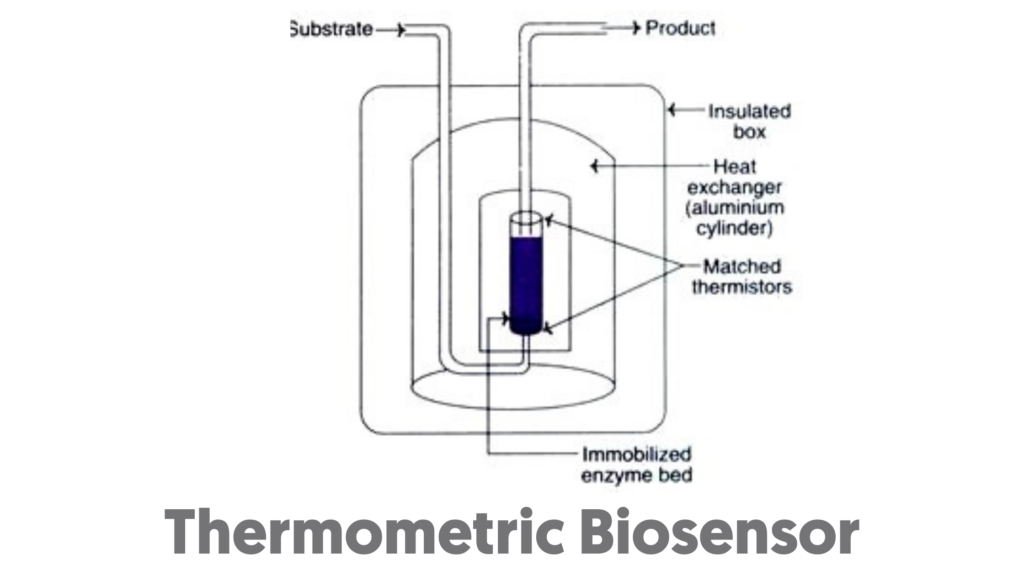
Image Source: www.biologydiscussion.com
These thermometric biosensors form the basis where there are a variety of biological reactions associated with the detection of heat. This sensor is also known as a thermal biosensor.
These sensors are also used to measure or estimate serum cholesterol. As the cholesterol enzyme gets oxidized by cholesterol oxidation, then heat will be generated which can be calculated. Similarly, glucose, urea, uric acid, and penicillin G can be assessed with these biosensors.
#3. Optical Biosensor:
An optical biosensor is a device that uses the principle of optical measurement. It uses fiber optics and optoelectronic transducers. The term optrode consists of the compression of the two words optical and electrode. These sensors mainly contain enzymes such as antibodies and transporting elements.
Allows safe non-electrical inaccessible sensing of optical biosensor equipment. The added advantage of this sensor is that frequent reference sensors are not required, as comparative signals can be generated using the same light source in the sample’s sensor.
These sensors are classified into two types, one is direct optical detection biosensors and the other is labeled optical detection biosensors.
#4. Wearable Biosensors:
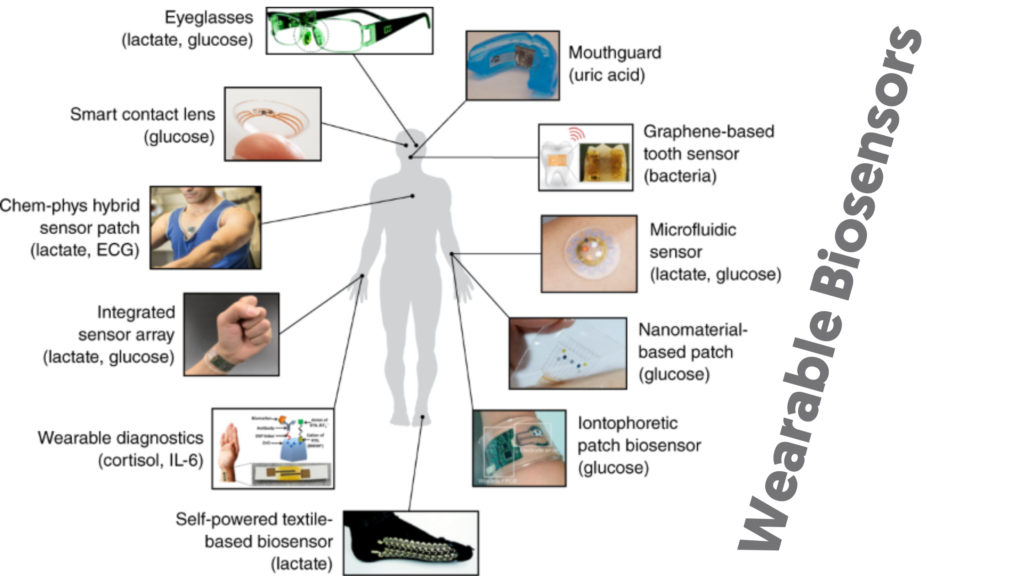
Wearable Biosensor is a digital device used to be worn on the human body in various wearable systems such as smartwatches, smart shoes, and tattoos that allow levels of blood glucose, BP, heartbeat, etc.
In today’s life, we have noticed that these sensors are signaling the improvement of health in the world. By using it well, the patient’s real-time fitness can be easily monitored. This data accessibility will allow superior medical choices and affect improved health outcomes and additional efficient use of health systems.
For humans, these sensors detect premature health action and can help prevent hospitalization. The possibility of these sensors reducing hospital investments and readings will certainly bring positive awareness in the near future.
Suggested Read: What is Chemical Earthing | How They Do It | Advantages of Chemical Earthing
#5. Enzyme Biosensor:
This is an analytical sensor used to merge enzymes using a transducer. Which produces a signal. Which is proportional to the concentration of the target analysis. Next, this signal can be expanded, stored, and processed for subsequent analysis.
#6. DNA Biosensor:
DNA biosensors can be developed based on nucleic acid identification techniques for the analysis of simple, rapid, and economical testing of genetic and infectious diseases. In addition, it is important to investigate specific DNA ranges in many areas such as food analysis, clinical, environmental, etc.
SAM and Selex techniques are used for better detection technology to develop better technology for DNA biosensors. Recognition of nucleic acid levels, separate from antibodies or enzymes, can be made voluntarily and regenerated for some use.
These sensors as well as gin chips have many advantages compared to normal hybrids as they have a huge ability to get specific data easily, cheaply, and quickly. Further, these sensors have been augmented, but, to expand sensor techniques, basic investigations for equipment for detecting plans, analysis, and action is still required.
#7. Immunosensors:
Immunosensors are recognized as the fact that antibodies typically bind to antibody toxins or pathogens or react through a component of the host immune system. Such antibodies include affinity with their specific antigens. This type of biosensor affinity relies on ligand solid-state devices. Where the immunochemical reaction transducer can be connected.
#8. Magnetic Biosensors:
This type of biosensor is used to measure magnetic-induced effects or reflexes within magnetic properties. This type of sensor coil uses super-paramagnetic otherwise paramagnetic crystals or particles to detect biological communication by measuring changes in magnetic properties such as changes in inductance resistance.
Suggested Read: Different Types of Sensors used in Automobiles
#9. Resonant Biosensors:
In resonant biosensors, like an acoustic wave, the transducer can be connected through a bio-element. Once the analyzer is attached to the atomic membrane. The mass of the membrane is then changed. Therefore, the final change in mass then changes the resonant frequency of the transducer. After that, the frequency change can be measured.
#10. Thermal Detection Biosensor:
Thermal Detection Biosensor type uses one of the basic biological reaction properties like heat production or absorption. The temperature changes when the reaction occurs. This sensor can be constructed by integrating the molecules of the immobile enzyme using the temperature sensor. Once the analyzer and the contact come into contact the heat response of the enzyme can be measured and adjusted against the concentration of the analyzer.
Otherwise, the total heat absorbed may be proportional to the enthalpy of the lentils and the total number of molecules within the reaction. Temperature measurements are usually achieved by thermistors called enzyme thermistors. Thermistors are ideal in some applications because they are sensitive to thermal changes.
Applications of Biosensors:
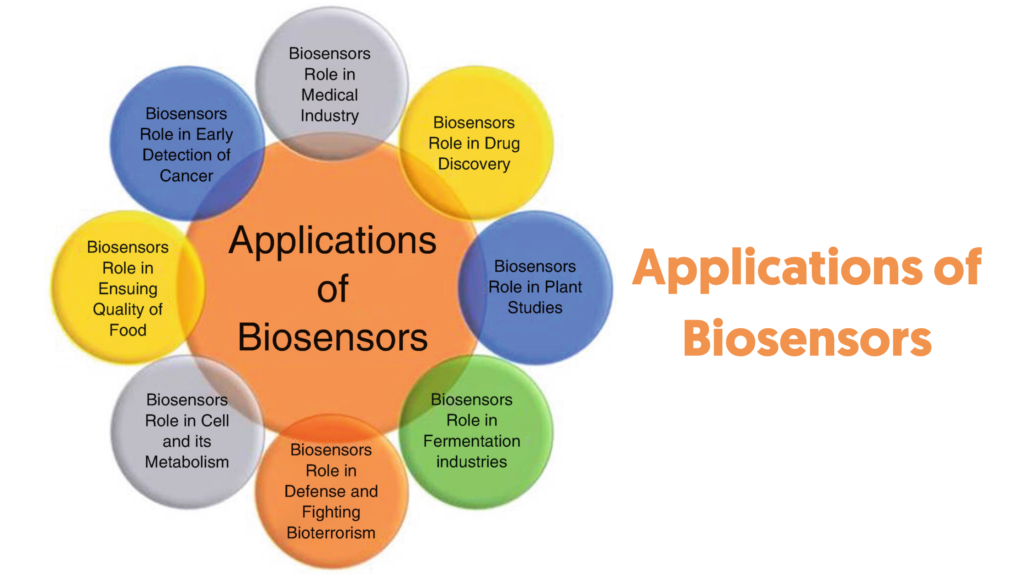
Ever since the invention of this biosensor, biosensors have become very important in the field of medicine, clinical, health, and general supervision of analysis. The benefits of lab-based biosensors are as follows.
- Small size.
- Fast result.
- Low cost.
- Extremely easy to use.
Apart from medical and health-based applications, biosensors are also important applications in many other fields such as industrial processing, agriculture, pollution control, food system, etc.
The following is a shortlist of potential areas in which biosensors are frequently used.
- Environmental monitoring.
- Medicine, clinical and diagnostic application.
- Agricultural industry.
- Industrial applications.
- Food industry.
#1. Environmental Monitoring:
Biosensors are widely used in the field of environmental pollution monitoring. Main curry and water pollution monitoring is an area where biosensors have a significant advantage. There are a lot of pollutants contaminating groundwater. As a result, drinking water is becoming contaminated.
Biosensors containing sensitizing elements for nitrates and phosphates are becoming commonplace in the fight against water pollutants. Another important application is made to find chemical and hazardous biological samples for full force. Which can be used as a bioweapon.
#2. Medicine, Clinical and Diagnostic Application:
The main areas of biosensors are medicine and clinical and diagnostic applications. Electrochemical-based biosensors are used in biochemical labs and clinics to monitor and measure glucose levels and lactic acid.
Commercial biosensors are becoming very popular in the field of personal health care. Self-monitoring of blood glucose, in particular, the main advantage of this method is that it cannot contaminate the blood sample and it is undone for more accurate results.
#3. Agricultural industry:
In the agricultural sector, biosensors are commonly used for the discovery of pesticides.
#4. Industrial Applications:
Fermentation is a large industrial operation used in dairy, alcohol, and similar products. Large-scale bacterial and cell cultures must be maintained for this purpose. These delicate but expensive processes need to be monitored to reduce production costs and risk-free fermentation.
#5. Food industry:
Commercial biosensors that can measure carbohydrates, alcohol, acids, etc. It is already available in the market. Biosensors are used in the food industry for the measurement of amino acids, carbohydrates, alcohols, gases, etc. to control food quality.
Like this post? Could you share it with your friends?
Suggested Read –